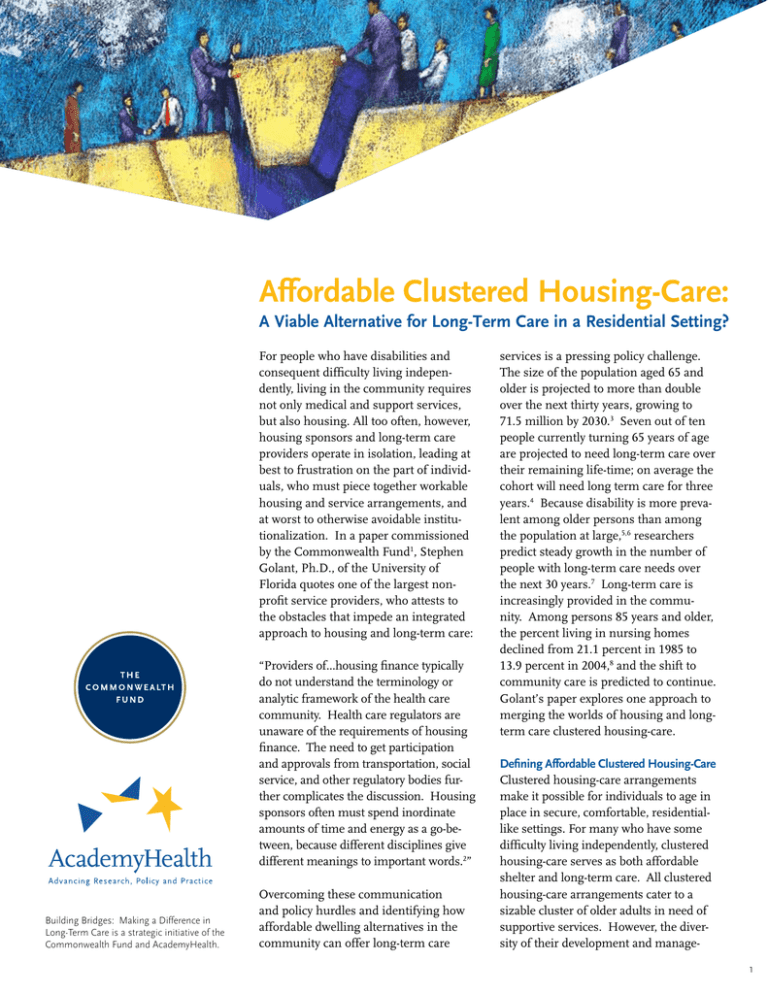Affordable Clustered Housing-Care:
advertisement

Affordable Clustered Housing-Care: A Viable Alternative for Long-Term Care in a Residential Setting? For people who have disabilities and consequent difficulty living independently, living in the community requires not only medical and support services, but also housing. All too often, however, housing sponsors and long-term care providers operate in isolation, leading at best to frustration on the part of individuals, who must piece together workable housing and service arrangements, and at worst to otherwise avoidable institutionalization. In a paper commissioned by the Commonwealth Fund1, Stephen Golant, Ph.D., of the University of Florida quotes one of the largest nonprofit service providers, who attests to the obstacles that impede an integrated approach to housing and long-term care: “Providers of...housing finance typically do not understand the terminology or analytic framework of the health care community. Health care regulators are unaware of the requirements of housing finance. The need to get participation and approvals from transportation, social service, and other regulatory bodies further complicates the discussion. Housing sponsors often must spend inordinate amounts of time and energy as a go-between, because different disciplines give different meanings to important words.2” Building Bridges: Making a Difference in Long-Term Care is a strategic initiative of the Commonwealth Fund and AcademyHealth. Overcoming these communication and policy hurdles and identifying how affordable dwelling alternatives in the community can offer long-term care services is a pressing policy challenge. The size of the population aged 65 and older is projected to more than double over the next thirty years, growing to 71.5 million by 2030.3 Seven out of ten people currently turning 65 years of age are projected to need long-term care over their remaining life-time; on average the cohort will need long term care for three years.4 Because disability is more prevalent among older persons than among the population at large,5,6 researchers predict steady growth in the number of people with long-term care needs over the next 30 years.7 Long-term care is increasingly provided in the community. Among persons 85 years and older, the percent living in nursing homes declined from 21.1 percent in 1985 to 13.9 percent in 2004,8 and the shift to community care is predicted to continue. Golant’s paper explores one approach to merging the worlds of housing and longterm care clustered housing-care. Defining Affordable Clustered Housing-Care Clustered housing-care arrangements make it possible for individuals to age in place in secure, comfortable, residentiallike settings. For many who have some difficulty living independently, clustered housing-care serves as both affordable shelter and long-term care. All clustered housing-care arrangements cater to a sizable cluster of older adults in need of supportive services. However, the diversity of their development and manage1 Affordable Clustered Housing-Care: A Viable Alternative for Long-Term Care in a Residential Setting? ment origins, types of services, service delivery strategies, and licensing statuses raise questions about the unique identity of clustered housing-care and whether these many arrangements share a common mission. Golant describes the distinguishing features of clustered housing-care, providing a typology of eight identifiable prototypes. His paper also identifies areas where additional research evidence is needed about the impact of clustered housing-care arrangements. A better understanding of the foundations of these arrangements and how they differ can guide policymakers and practitioners as they move forward in developing affordable housing and long-term care options. Affordable clustered housing-care, the nomenclature used by Golant, is commonly referred to by a variety of labels: service enriched affordable housing; affordable supportive housing; affordable assisted housing; affordable housing plus services; subsidized naturally occurring retirement communities (NORC); assisted living in public housing; and service coordinated housing. While the development, management, population, and services provided differ widely among these housing care arrangements, they share commonalities as well. Each of these entities arranges for delivery of affordable shelter and longterm care services to sizable population clusters of low-income frail persons. Services in clustered housing-care settings are provided by onsite staff hired by the housing provider or by home and community-based health and service providers under contract or in partnership arrangements. The “service” staff in these settings may range from only a “service coordinator” who helps the older tenants secure needed assistance to personal aides providing hands-on care. Often facilities provide care through some combination of staffing and outsourcing arrangements. The services offered in clustered housing-care settings range from information, counsel2 ing, housekeeping, meals, and transportation to personal care, health care, and nursing services. These services are delivered using a person-centered approach that emphasizes individual autonomy and choice. Golant describes nine features of affordable clustered housing-care that distinguish it from other models of long-term care delivery, particularly from household-care, which he defines as care typically provided by family members or hired workers to individual seniors living in ordinary owner- or renter-occupied housing. The identifiable components of affordable clustered housing-care are: u u u Development and Management Origins: The dwellings are originally planned or purposely adapted, and maintenance and rent are designed, to accommodate low-income older persons. Long-term care is affordable to those who need it. Typically, those initiating these arrangements are: administrators or owners of government-subsidized affordable, rent-assisted apartment projects; nonprofit organizations; privately owned assisted living residences; or self organized groups of buildingspecific older residents. Setting Context and Composition of Occupants: The buildings are purposely occupied by a significant concentration or critical mass of older persons with chronic physical health problems and/or cognitive deficits who require assistance with activities of daily living. The seriousness or acuity of their vulnerabilities can vary substantially, reflecting the philosophy of the service provider and regulatory constraints. Building Site Characteristics: The residences of older persons are usually rented or owned dwellings in multi-unit buildings. They can also be single-family dwellings in the same neighborhood or on a campus setting. u Features for the Physically or Cognitively Frail: Physical or architectural features are designed to meet the needs of physically or cognitively impaired occupants, often meeting federal, state, or local regulatory requirements. Common living areas often accommodate the recreational, life-style, and dining activities of the residents, and workplaces are available for staff to administer care. u Long-Term Care Services Offered: Low acuity (housekeeping, information, and transportation) to high acuity (nursing home level) care is offered over a sustained period. The level of care reflects the capabilities and service philosophy of the providers or restrictions imposed by government regulations. u Service Delivery Modes: A housing manager or tenant organization hires or contracts with staff or collaborates with public agencies, nonprofit organizations, community service agencies, or private businesses to assist residents in the long term care delivery process. Occupants rarely make long term care decisions alone. The extent to which they are involved in the management and programming of their care varies. u Licensure and Regulatory Status: The regulatory status of these housing arrangements varies. Sometimes only the building is regulated under local housing and zoning laws, while in other settings the building and the services offered are regulated by state law. Alternatively, only the providers outsourced under contract are licensed or regulated by a state agency. u Affordability of Shelter: Clustered housing-care arrangements may include federally- or state-subsidized rental housing, as well as market rate housing designed to be reasonably affordable to those with modest incomes. The latter might include Affordable Clustered Housing-Care: A Viable Alternative for Long-Term Care in a Residential Setting? limited equity cooperatives, rentcontrolled buildings, manufactured home parks, or dwellings in older neighborhoods. u Affordability of Long-Term Care: Supportive services are made affordable through multiple strategies, including use of public programs, private foundation support, and service delivery by non-profit (often faith-based) organizations. Impact of Affordable Clustered Housing-Care Advocates argue that affordable clustered housing-care makes it more likely that poor and frail older Americans can age in place in residential-like settings comparable to assisted living properties catering to higher income elders. In contrast to household-care, these arrangements benefit from greater economies of scale, serving a relatively large and permanent concentration of low income elders with common needs. This critical mass helps to justify investing in the infrastructure and service delivery for clustered housingcare, including: retrofitting the building to make it safe and accessible; hiring a service coordinator or manager; purchasing a transportation van; offering on-site meals and personal assistance; and providing social and recreational activities. Service providers note that obtaining information on the residents’ needs is more feasible in a clustered housingcare setting than when the elders are geographically dispersed and receiving household care from a variety of informal caregivers.9 According to Golant, some of the strongest proponents of affordable housing-care are sponsors of rent-subsidized buildings who adopted the model after having experienced a host of tenant crises in the absence of supportive services. Golant argues that clustered housing-care offers a more comprehensive array of services less expensively, more effectively, and with better results than household-care. Family members providing care typically have little experience with the burdens of their responsibilities, and in the course of their care-giving often incur physical and psychological health problems. Those relying on paid services in their own homes may be limited by providers’ schedules, rather than having assistance available when it is most needed. While advocates are quick to point out the advantages of clustered housing-care, there are also obstacles that discourage its growth. The process for housing providers to secure funding to construct or retrofit suitable structures, while also delivering affordable care, is complex. In particular, it is often difficult for them to obtain Medicaid waiver support and affordable rental voucher subsidy assistance at the same time. As mentioned earlier, coordinating housing and longterm care frequently requires the interaction of many regulatory bodies that are not accustomed to working together. The obstacles to obtaining funding for both the shelter and service components of clustered housing-care arrangements often derail them. Nursing homes also are single “shelter and care” entities; however, they usually rely on Medicaid as the primary source of reimbursement for both housing and care. Assisted living facilities, typically catering to higher income clientele, usually do not rely on public funding. can achieve acceptable quality of life and care outcomes.” Studies must carefully delineate the various versions of this option and the strengths and weaknesses of each for the aging in place of older persons. In particular, evidence is needed about whether and how clustered housing-care helps occupants improve or stabilize behavioral functioning, delay or postpone the need for a nursing home stay, and reduce the overall costs of publicly funded longterm care. A broader evidence base of policy-relevant research could do much to address the following questions about affordable clustered housing-care: u What are the quality implications of various staffing arrangements, including onsite staffing, outsourcing, or partnering/co-location options for the provision of long term care services? u What are the quality implications of licensing the property, as opposed to the service provider, as long-term care providers? u What are the parameters of an operationally feasible critical mass (resident population)? u Which program features (e.g., hours of onsite care, etc.) most influence resident care outcomes? u How The Future of Affordable Clustered Housing-Care The multiple prototypes of affordable clustered housing-care offer lower income seniors more choices with respect to their varied housing preferences and long-term care needs. However, the diversity also contributes to the failure of research to draw lessons about the positive contribution affordable clustered housing-care can make to providing quality long term care to America’s aging population. Golant concludes, “Currently, there is a shortage of scientifically valid research that has demonstrated that this housing-care alternative do the costs and quality of care in clustered housing-care compare to those for household-care and private pay assisted living facilities? u What minimum set of attributes is required for clustered housing-care arrangements to qualify as an alternative to high acuity facilities such as private pay assisted living or nursing homes? Despite the commonalities among affordable clustered housing-care arrangements and their potential for offering long term care services, their diversity clouds their identity and raises uncertainty about their mission. This ambi3 Affordable Clustered Housing-Care: A Viable Alternative for Long-Term Care in a Residential Setting? guity both contributes to and is perpetuated by the lack of a coherent and compelling body of scientific evidence about their residents’ quality of life and care. Additional research is necessary to address concerns about whether these less stringently regulated arrangements can provide a better quality of life and competent care to older persons seeking to avoid nursing home stays.10 Endnotes 1 Golant, S.M., “Affordable Clustered HousingCare: A Category of Long-Term Care Options for the Elderly Poor,” paper commissioned by the Commonwealth Fund under its Building Bridges: Making a Difference in Long-Term Care strategic initiative. Original version of paper presented at Building Bridges colloquium, June 25, 2005, Boston, MA; revised version is forthcoming in Vol. 21, No. 3, 2008 issue of the Journal of Housing for the Elderly. 2 Felgar, L.J. Volunteers of America, Testimony to The Commission on Affordable Housing and Health Facility Needs for Seniors in the 21st Century, San Diego, CA., November 7, 2001, www. govinfo.library.unt.edu/seniorscommission/ pages/hearings/011107/felgar.html. 3 U.S. Census Bureau. U.S. Interim Projections by Age, Sex, Race, And Hispanic Origin, Summary Table 2a, 2004, www.census.gov/ipc/ www/usinterimproj/ . 4 Kemper, P., et.al., “Long-Term Care Over An Uncertain Future: What Can Current Retirees Expect?” Inquiry, Vol. 42, No. 4, December 1, 2005, pp. 335-350. 5 In 2000, approximately 45 percent of the general population had chronic conditions and 21 percent had multiple chronic conditions, while 62 percent of those over 65 had multiple chronic conditions according to Anderson, G. and J. Hor- vath, “The Growing Burden of Chronic Disease in America,” Public Health Reports, Vol. 119, May-June 2004, p. 263, www.publichealthreports. org/userfiles/119_3/119263.pdf . 6 The American Geriatrics Society & The AGS Foundation for Health in Aging, “Fact Sheet on Aging and Health in America.” 7 Ibid. 8 Alecxih, L. “Nursing Home Use By ‘Oldest Old’ Sharply Declines.” Washington, DC: The Lewin Group, 2006. 9 Evashwick, C. and T.J. Holt. 2000. “Integrating Long-Term Care, Acute Care, and Housing: Building Success Through a Continuum of Care.’ St. Louis, MO: The Catholic Health Association of the United States. 10 U.S. Senate Special Committee on Aging, Assisted Living: Examining the Assisted Living Workgroup Final Report, Hearing 2003, Washington: U.S. Government Printing Office.




